jump start FORD EXPEDITION 2004 2.G Owners Manual
[x] Cancel search | Manufacturer: FORD, Model Year: 2004, Model line: EXPEDITION, Model: FORD EXPEDITION 2004 2.GPages: 344, PDF Size: 11.56 MB
Page 2 of 344
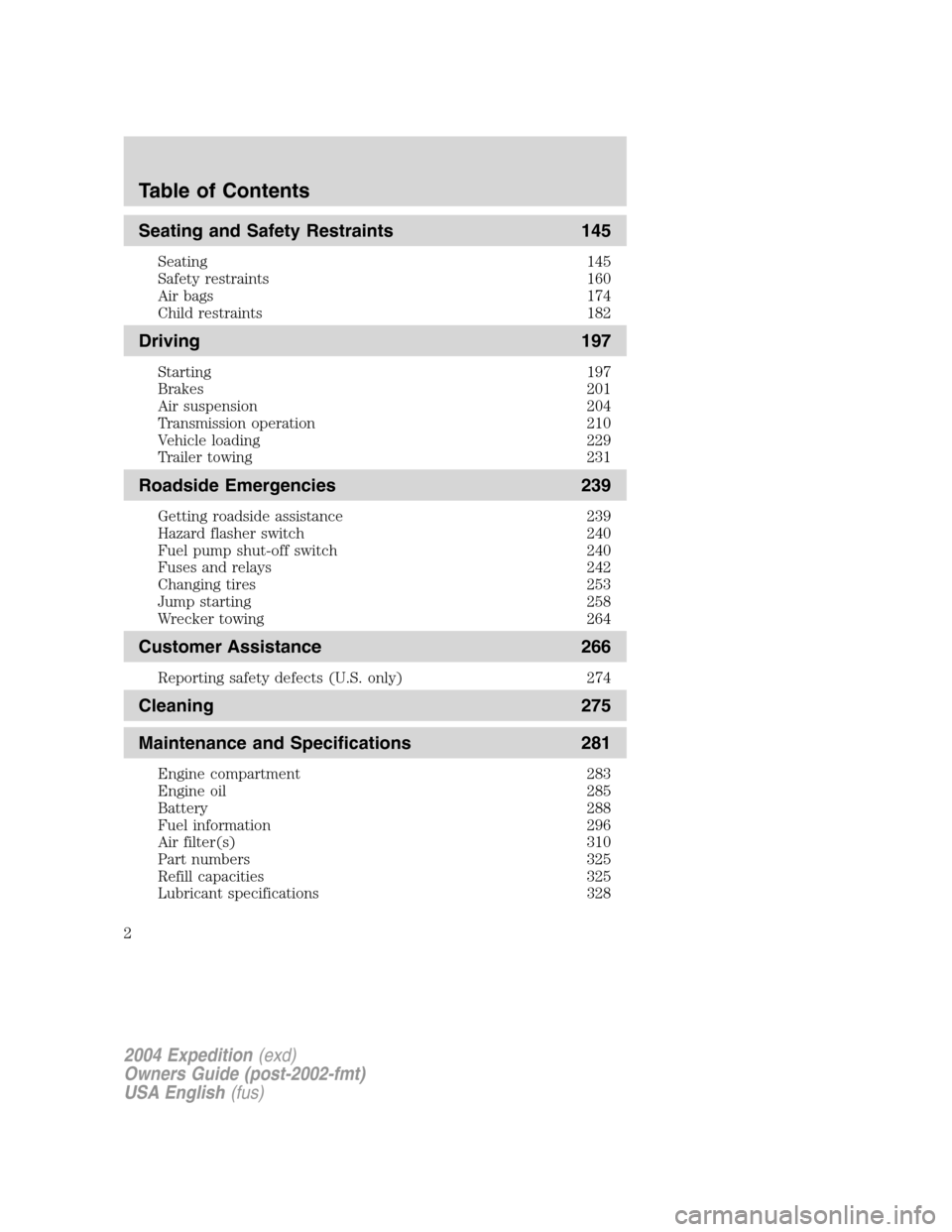
Seating and Safety Restraints 145
Seating 145
Safety restraints 160
Air bags 174
Child restraints 182
Driving 197
Starting 197
Brakes 201
Air suspension 204
Transmission operation 210
Vehicle loading 229
Trailer towing 231
Roadside Emergencies 239
Getting roadside assistance 239
Hazard flasher switch 240
Fuel pump shut-off switch 240
Fuses and relays 242
Changing tires 253
Jump starting 258
Wrecker towing 264
Customer Assistance 266
Reporting safety defects (U.S. only) 274
Cleaning 275
Maintenance and Specifications 281
Engine compartment 283
Engine oil 285
Battery 288
Fuel information 296
Air filter(s) 310
Part numbers 325
Refill capacities 325
Lubricant specifications 328
2004 Expedition(exd)
Owners Guide (post-2002-fmt)
USA English(fus)
Table of Contents
2
Page 239 of 344
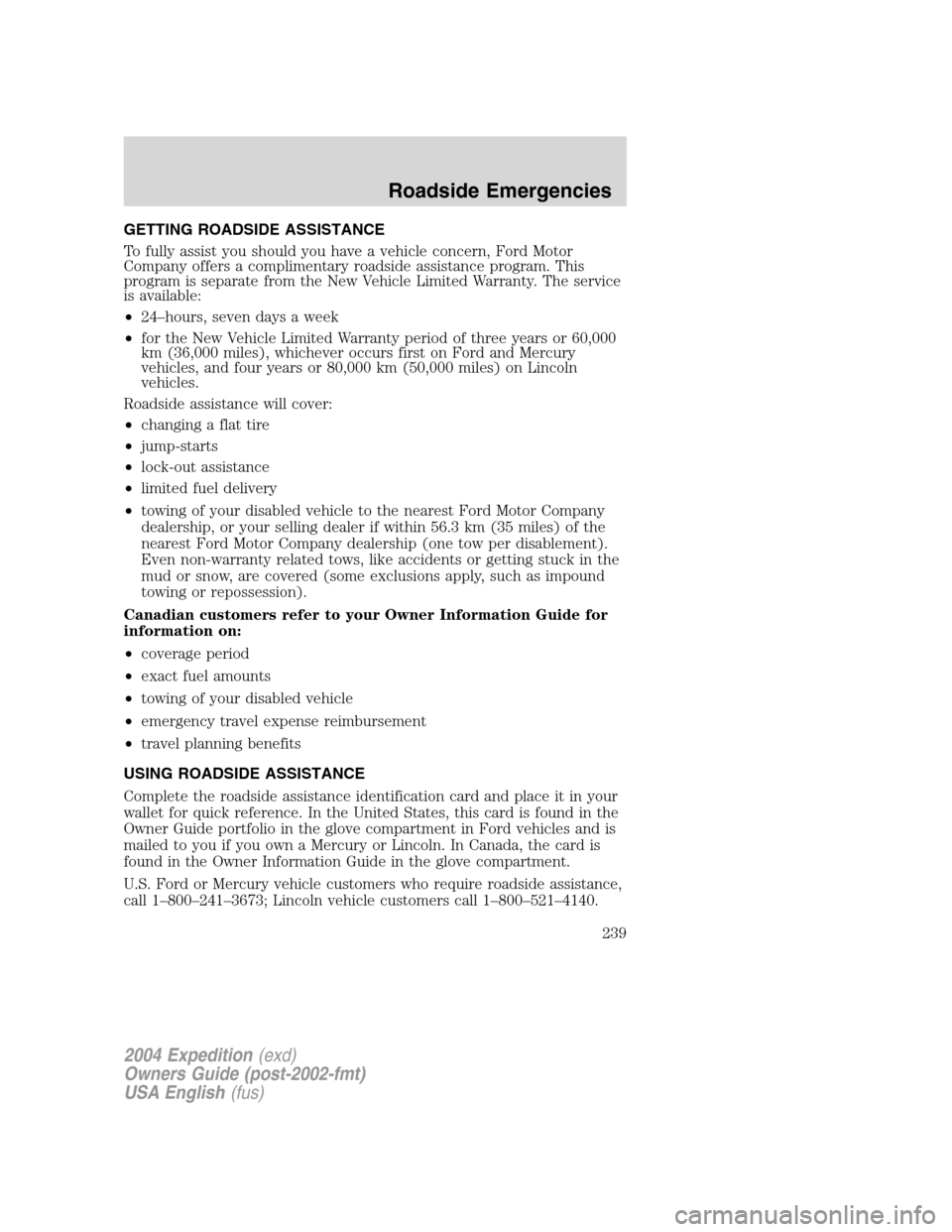
GETTING ROADSIDE ASSISTANCE
To fully assist you should you have a vehicle concern, Ford Motor
Company offers a complimentary roadside assistance program. This
program is separate from the New Vehicle Limited Warranty. The service
is available:
•24–hours, seven days a week
•for the New Vehicle Limited Warranty period of three years or 60,000
km (36,000 miles), whichever occurs first on Ford and Mercury
vehicles, and four years or 80,000 km (50,000 miles) on Lincoln
vehicles.
Roadside assistance will cover:
•changing a flat tire
•jump-starts
•lock-out assistance
•limited fuel delivery
•towing of your disabled vehicle to the nearest Ford Motor Company
dealership, or your selling dealer if within 56.3 km (35 miles) of the
nearest Ford Motor Company dealership (one tow per disablement).
Even non-warranty related tows, like accidents or getting stuck in the
mud or snow, are covered (some exclusions apply, such as impound
towing or repossession).
Canadian customers refer to your Owner Information Guide for
information on:
•coverage period
•exact fuel amounts
•towing of your disabled vehicle
•emergency travel expense reimbursement
•travel planning benefits
USING ROADSIDE ASSISTANCE
Complete the roadside assistance identification card and place it in your
wallet for quick reference. In the United States, this card is found in the
Owner Guide portfolio in the glove compartment in Ford vehicles and is
mailed to you if you own a Mercury or Lincoln. In Canada, the card is
found in the Owner Information Guide in the glove compartment.
U.S. Ford or Mercury vehicle customers who require roadside assistance,
call 1–800–241–3673; Lincoln vehicle customers call 1–800–521–4140.
2004 Expedition(exd)
Owners Guide (post-2002-fmt)
USA English(fus)
Roadside Emergencies
Roadside Emergencies
239
Page 258 of 344
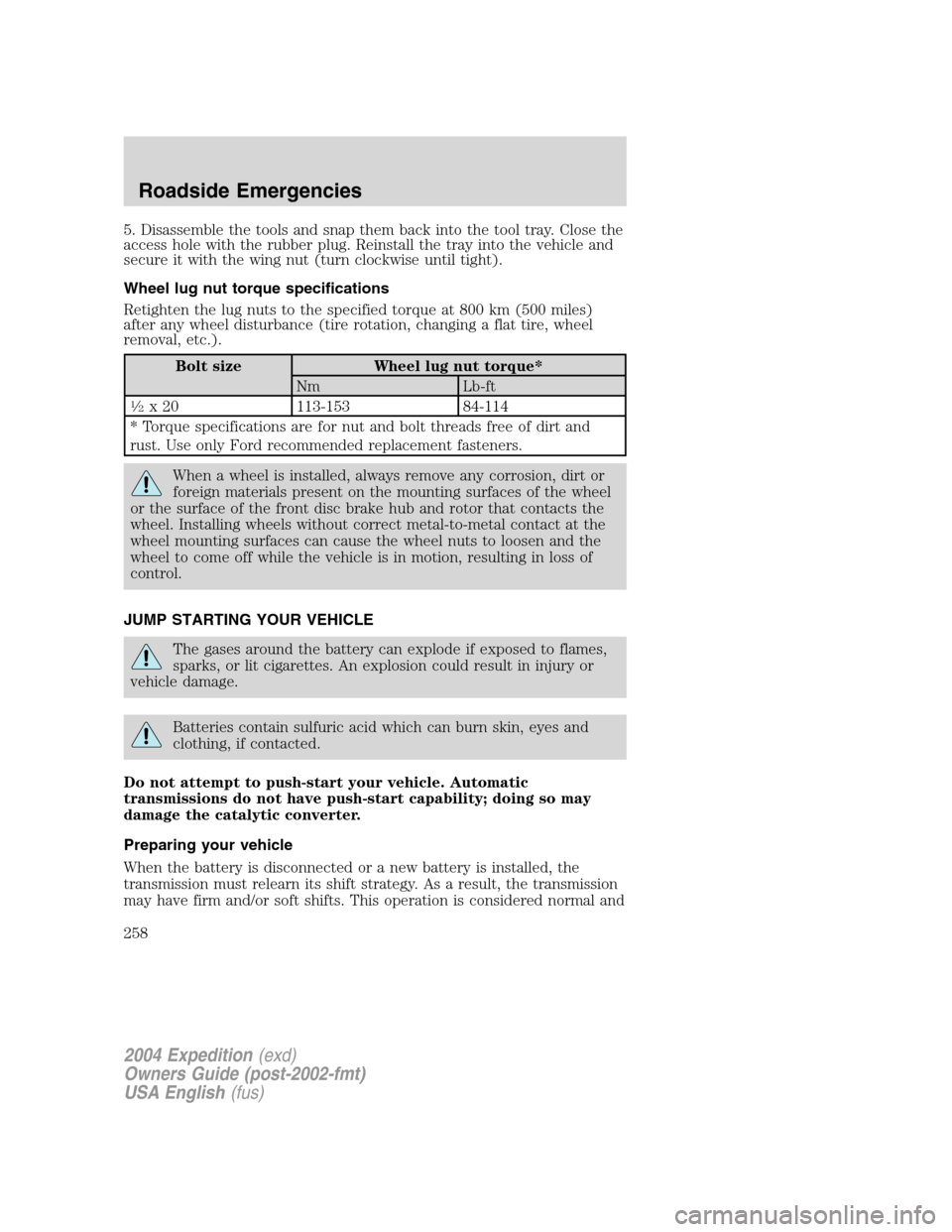
5. Disassemble the tools and snap them back into the tool tray. Close the
access hole with the rubber plug. Reinstall the tray into the vehicle and
secure it with the wing nut (turn clockwise until tight).
Wheel lug nut torque specifications
Retighten the lug nuts to the specified torque at 800 km (500 miles)
after any wheel disturbance (tire rotation, changing a flat tire, wheel
removal, etc.).
Bolt size Wheel lug nut torque*
Nm Lb-ft
1�2x 20 113-153 84-114
* Torque specifications are for nut and bolt threads free of dirt and
rust. Use only Ford recommended replacement fasteners.
When a wheel is installed, always remove any corrosion, dirt or
foreign materials present on the mounting surfaces of the wheel
or the surface of the front disc brake hub and rotor that contacts the
wheel. Installing wheels without correct metal-to-metal contact at the
wheel mounting surfaces can cause the wheel nuts to loosen and the
wheel to come off while the vehicle is in motion, resulting in loss of
control.
JUMP STARTING YOUR VEHICLE
The gases around the battery can explode if exposed to flames,
sparks, or lit cigarettes. An explosion could result in injury or
vehicle damage.
Batteries contain sulfuric acid which can burn skin, eyes and
clothing, if contacted.
Do not attempt to push-start your vehicle. Automatic
transmissions do not have push-start capability; doing so may
damage the catalytic converter.
Preparing your vehicle
When the battery is disconnected or a new battery is installed, the
transmission must relearn its shift strategy. As a result, the transmission
may have firm and/or soft shifts. This operation is considered normal and
2004 Expedition(exd)
Owners Guide (post-2002-fmt)
USA English(fus)
Roadside Emergencies
258
Page 259 of 344
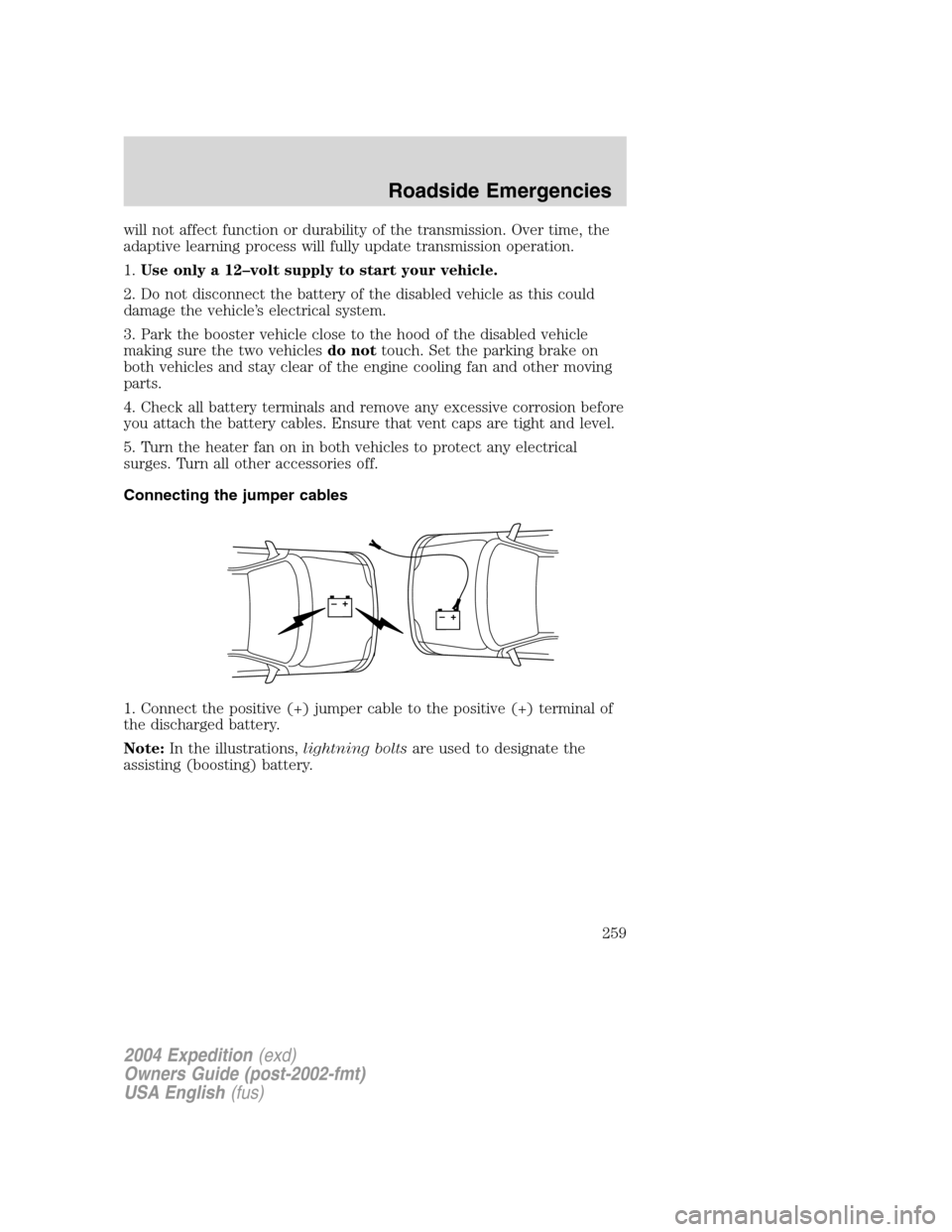
will not affect function or durability of the transmission. Over time, the
adaptive learning process will fully update transmission operation.
1.Use only a 12–volt supply to start your vehicle.
2. Do not disconnect the battery of the disabled vehicle as this could
damage the vehicle’s electrical system.
3. Park the booster vehicle close to the hood of the disabled vehicle
making sure the two vehiclesdo nottouch. Set the parking brake on
both vehicles and stay clear of the engine cooling fan and other moving
parts.
4. Check all battery terminals and remove any excessive corrosion before
you attach the battery cables. Ensure that vent caps are tight and level.
5. Turn the heater fan on in both vehicles to protect any electrical
surges. Turn all other accessories off.
Connecting the jumper cables
1. Connect the positive (+) jumper cable to the positive (+) terminal of
the discharged battery.
Note:In the illustrations,lightning boltsare used to designate the
assisting (boosting) battery.
+–+–
2004 Expedition(exd)
Owners Guide (post-2002-fmt)
USA English(fus)
Roadside Emergencies
259
Page 261 of 344
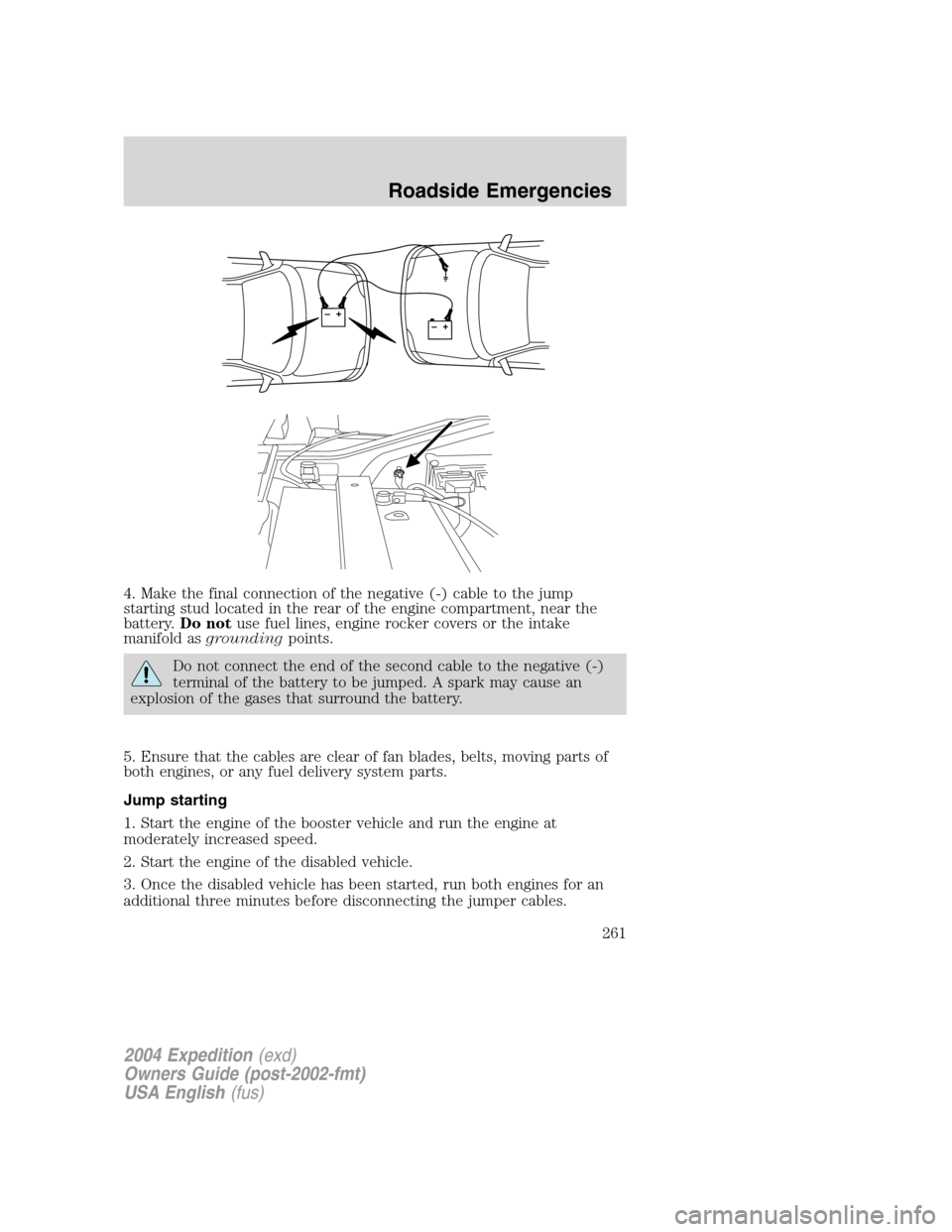
4. Make the final connection of the negative (-) cable to the jump
starting stud located in the rear of the engine compartment, near the
battery.Do notuse fuel lines, engine rocker covers or the intake
manifold asgroundingpoints.
Do not connect the end of the second cable to the negative (-)
terminal of the battery to be jumped. A spark may cause an
explosion of the gases that surround the battery.
5. Ensure that the cables are clear of fan blades, belts, moving parts of
both engines, or any fuel delivery system parts.
Jump starting
1. Start the engine of the booster vehicle and run the engine at
moderately increased speed.
2. Start the engine of the disabled vehicle.
3. Once the disabled vehicle has been started, run both engines for an
additional three minutes before disconnecting the jumper cables.
+–+–
2004 Expedition(exd)
Owners Guide (post-2002-fmt)
USA English(fus)
Roadside Emergencies
261
Page 263 of 344
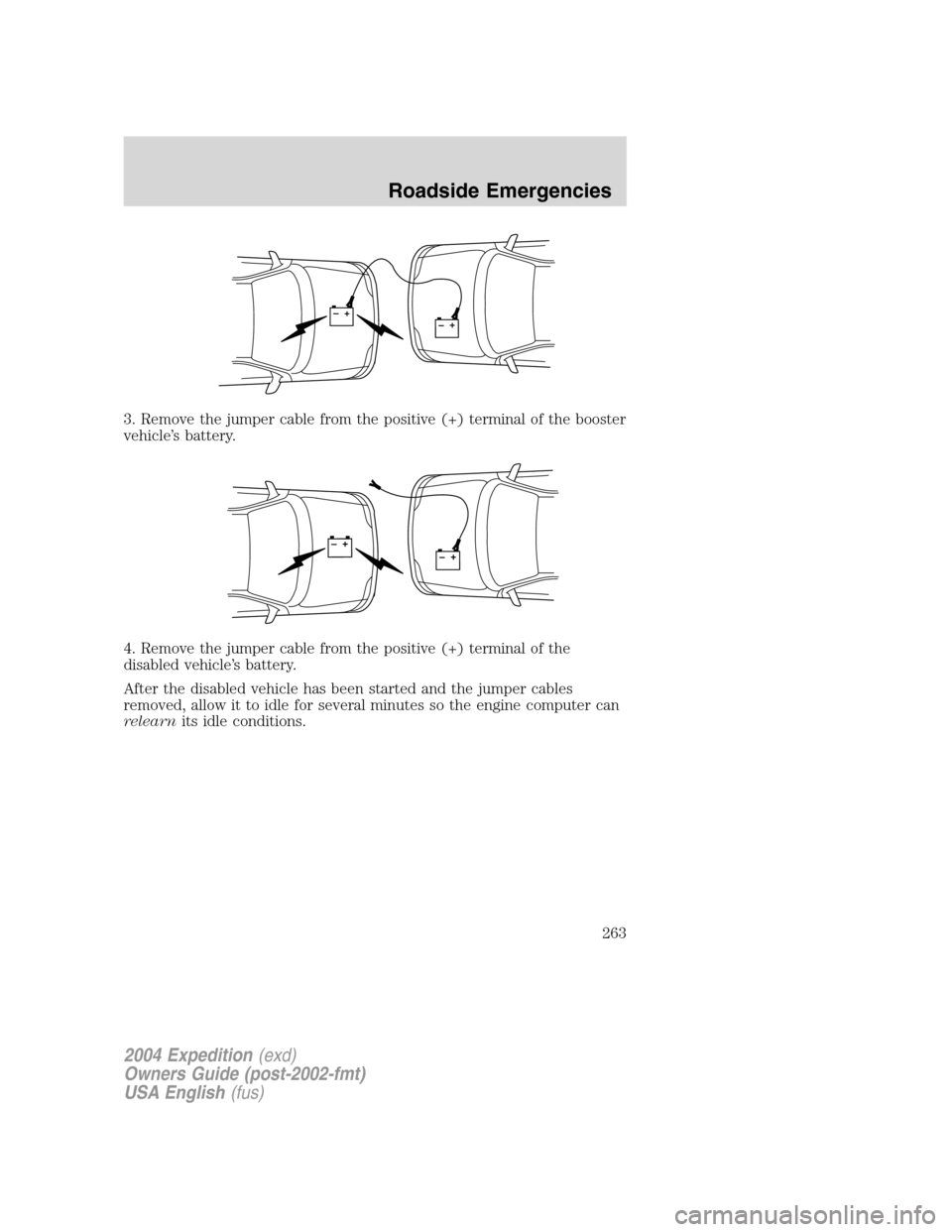
3. Remove the jumper cable from the positive (+) terminal of the booster
vehicle’s battery.
4. Remove the jumper cable from the positive (+) terminal of the
disabled vehicle’s battery.
After the disabled vehicle has been started and the jumper cables
removed, allow it to idle for several minutes so the engine computer can
relearnits idle conditions.
+–+–
+–+–
2004 Expedition(exd)
Owners Guide (post-2002-fmt)
USA English(fus)
Roadside Emergencies
263
Page 340 of 344
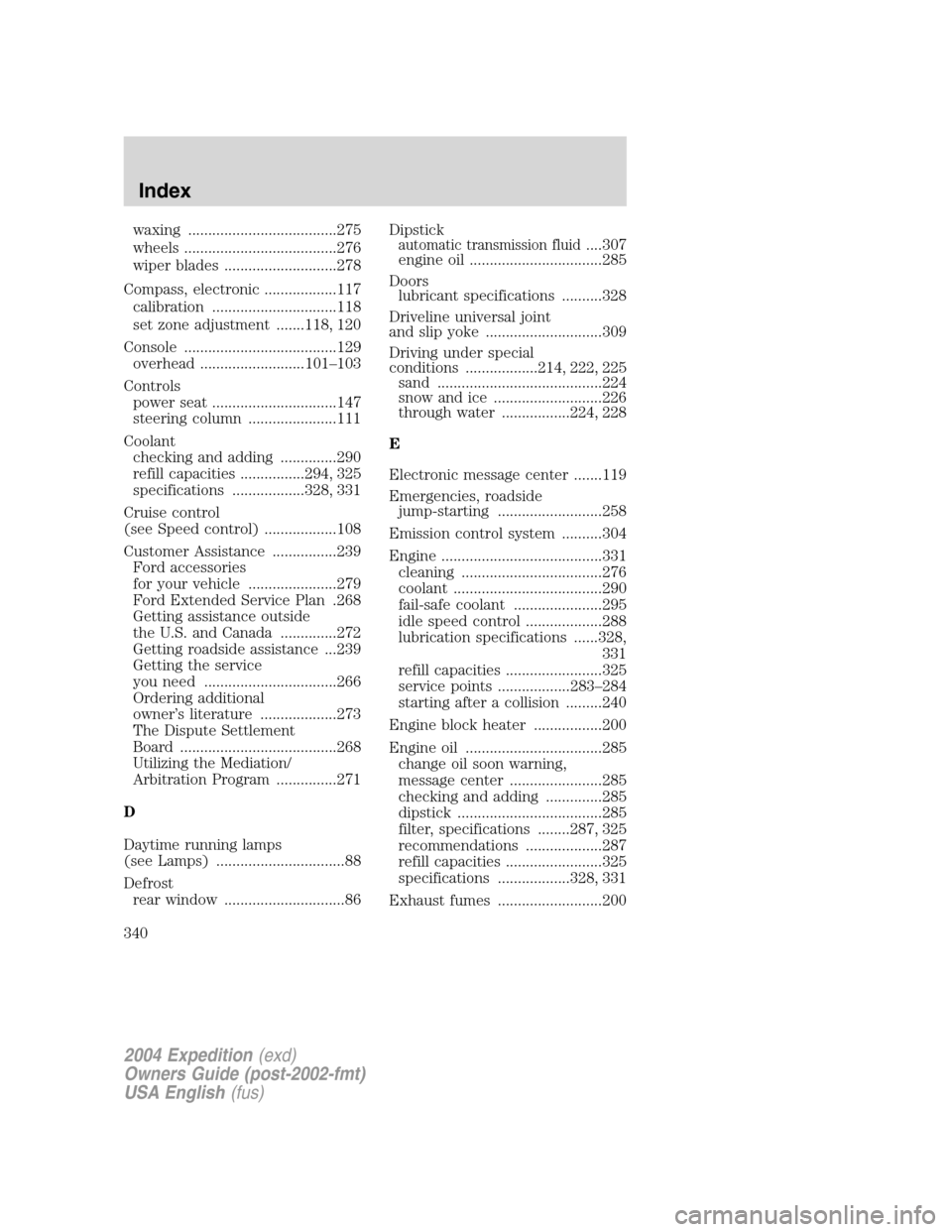
waxing .....................................275
wheels ......................................276
wiper blades ............................278
Compass, electronic ..................117
calibration ...............................118
set zone adjustment .......118, 120
Console ......................................129
overhead ..........................101–103
Controls
power seat ...............................147
steering column ......................111
Coolant
checking and adding ..............290
refill capacities ................294, 325
specifications ..................328, 331
Cruise control
(see Speed control) ..................108
Customer Assistance ................239
Ford accessories
for your vehicle ......................279
Ford Extended Service Plan .268
Getting assistance outside
the U.S. and Canada ..............272
Getting roadside assistance ...239
Getting the service
you need .................................266
Ordering additional
owner’s literature ...................273
The Dispute Settlement
Board .......................................268
Utilizing the Mediation/
Arbitration Program ...............271
D
Daytime running lamps
(see Lamps) ................................88
Defrost
rear window ..............................86Dipstickautomatic transmission fluid....307
engine oil .................................285
Doors
lubricant specifications ..........328
Driveline universal joint
and slip yoke .............................309
Driving under special
conditions ..................214, 222, 225
sand .........................................224
snow and ice ...........................226
through water .................224, 228
E
Electronic message center .......119
Emergencies, roadside
jump-starting ..........................258
Emission control system ..........304
Engine ........................................331
cleaning ...................................276
coolant .....................................290
fail-safe coolant ......................295
idle speed control ...................288
lubrication specifications ......328,
331
refill capacities ........................325
service points ..................283–284
starting after a collision .........240
Engine block heater .................200
Engine oil ..................................285
change oil soon warning,
message center .......................285
checking and adding ..............285
dipstick ....................................285
filter, specifications ........287, 325
recommendations ...................287
refill capacities ........................325
specifications ..................328, 331
Exhaust fumes ..........................200
2004 Expedition(exd)
Owners Guide (post-2002-fmt)
USA English(fus)
Index
340
Page 342 of 344

Infant seats
(see Safety seats) .....................186
Inspection/maintenance
(I/M) testing ..............................305
Instrument panel
cleaning ...................................278
cluster ........................................10
lighting up panel and interior...89
J
Jack ............................................253
positioning ...............................253
storage .....................................253
Jump-starting your vehicle ......258
K
Keyless entry system
programming entry code .......140
Keys ...................................141–143
positions of the ignition .........197
L
Lamps
autolamp system .......................87
bulb replacement
specifications chart ..................92
daytime running light ...............88
fog lamps ...................................87
headlamps .................................87
headlamps, flash to pass ..........88
instrument panel, dimming .....89
interior lamps .....................90–93
replacing bulbs .............91, 93–96
Lane change indicator
(see Turn signal) ........................90
Liftgate ..............................130, 134
Lights, warning and indicator ....10anti-lock brakes (ABS) ..........202
Limited-slip axle .......................207
Load limits .................................229
GAWR ......................................229
GVWR ......................................229
trailer towing ..........................229
Loading instructions .................230
Locks
childproof ................................132
doors ........................................132
Lubricant specifications ...328, 331
Lumbar support, seats .............147
M
Message center .........................119
english/metric button .............124
system check button ..............125
warning messages ...................125
Mirrors ...............................101, 106
automatic dimming
rearview mirror .......................106
fold away .................................108
heated ......................................107
programmable memory ..135, 148
side view mirrors (power) .....107
Moon roof ..................................102
Motorcraft parts ................300, 325
N
Navigation system .......................44
quick start .................................48
radio functions ..........................50
setting the clock .......................77
O
Octane rating ............................299
2004 Expedition(exd)
Owners Guide (post-2002-fmt)
USA English(fus)
Index
342
Page 344 of 344

Speed control ............................108
Starting your vehicle ........197–199
jump starting ..........................258
Steering
speed sensitive .......................204
Steering wheel
controls ....................................111
T
Tire Pressure Monitoring
System (TPMS)
Driving .....................................224
Roadside Emergencies ...........253
Warning Displays ......................14
Tires ...................................253, 311
changing ..................253–254, 258
snow tires and chains ............324
tire grades ...............................312
treadwear ................................311
Towing .......................................231
recreational towing .................237
trailer towing ..........................231
wrecker ....................................264
Transmission .............................210
brake-shift interlock (BSI) ....210
fluid, checking and adding
(automatic) .............................307fluid, refill capacities ..............325
lubricant specifications ..328, 331
Trunk .........................................134
Turn signal ..................................90
V
Vehicle dimensions ...................331
Vehicle Identification Number
(VIN) ..........................................333
Vehicle loading ..........................229
Ventilating your vehicle ...........200
W
Warning lights (see Lights) .......10
Washer fluid ..............................285
Water, Driving through .............228
Windows
power .......................................105
rear wiper/washer ...................100
Windshield washer fluid and
wipers ..........................................99
checking and adding fluid .....285
liftgate reservoir .....................285
replacing wiper blades ...........100
Wrecker towing .........................264
2004 Expedition(exd)
Owners Guide (post-2002-fmt)
USA English(fus)
Index
344